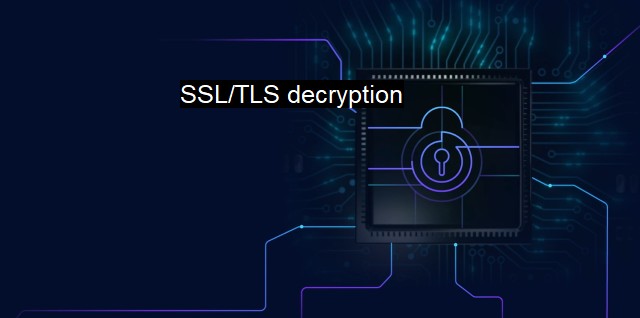What is SSL/TLS decryption?
Demystifying SSL/TLS Decryption for Improved Cybersecurity and Antivirus Defense
SSL/TLS decryption is a crucial subject in the world of cybersecurity and antivirus. Standing for Secure Sockets Layer and Transport Layer Security, respectively, SSL and TLS are cryptographic protocols designed to provide security and data integrity for communications over networks such as the internet. To understand SSL/TLS decryption, one must first understand these protocols and their significance in securing digital communications.Protecting data during transmission over the internet is critical in today's digital world. The communication between a client and server often carries sensitive information such as login credentials, credit card numbers, or personal details. To safeguard these details, SSL/TLS protocols are used, which work on a complex system of encryption and decryption.
Encryption served by these protocols is driven by symmetric and asymmetric encryption algorithms. The process begins when the client communicates with the server, initiating what is known as an SSL/TLS handshake. This process involves the negotiation of the security keys to be used during the transmission. A private key, known only by the server, and a public key, which can be openly distributed, are employed to make the data impossible to read in case the transmission is intercepted.
Once the secure channels have been arranged and the keys have been exchanged, the transfer of data can begin. The server, with its private key, and the client's public key transmits the encryption of the data. Suppose an attacker tries to intercept the data. In that case, they find it unreadable or incomprehensible because of the encryption.
SSL/TLS decryption is the reverse process of the encrypted data. After the encrypted data is transmitted, there comes the need to translate it back to a comprehensible format or plain text. The receiver uses the private key or shared symmetric key to decrypt the cipher text back into readable data.
This decryption process takes place under exceptional security measures. For instance, in a typical SSL/TLS set-up, only the intended recipient, who possesses the appropriate private key, can decrypt this data. This ensures that even if any person or entity intercepts the transmission of the encrypted data, they will not be able to decrypt it into something comprehensible.
Despite the security levels offered by SSL/TLS, there are instances where decryption is necessary from a cybersecurity standpoint. This process is known as SSL/TLS decryption or SSL/TLS inspection. SSL/TLS inspection is primarily employed by businesses and network security devices to review the encrypted communication for any security threats.
Although SSL/TLS encryption plays a pivotal role in digital security by ensuring that data is unreadable to unauthorized individuals, it presents a challenge for cybersecurity professionals. Encryption can act as a double-edged sword. While on the one side, it safeguards sensitive data from hackers and cybercriminals, it can also serve as a perfect disguise for those malevolent entities to hide their malicious activities.
As a countermeasure, organizations often incorporate SSL/TLS decryption in their secure gateway solutions to scrutinize the incoming or outgoing encrypted traffic. This allows cybersecurity professionals to analyze and monitor encrypted traffic for threats, malware, data loss, and other potential risks, which might otherwise remain undetected under the mask of encryption.
SSL or TLS decryption is a key factor in fostering a secure online environment. It assures data integrity, confidentiality and enhances the robust nature of digital connections. It plays a significant role in antivirus systems and cybersecurity by enabling security inspection of encrypted data, ensuring not only the safeguarding of legitimate data but also the exposure of any hidden threats. Despite its complexity, the system of encryption and decryption used in SSL and TLS forms the backbone of online security, shielding users from a significant proportion of cyber threats.

SSL/TLS decryption FAQs
What is SSL/TLS decryption?
SSL/TLS decryption refers to the process of intercepting and decrypting encrypted traffic that is transmitted over secure communication protocols such as SSL and TLS. This is often necessary in cybersecurity to monitor network traffic for malicious activities or to enforce security policies.Why is SSL/TLS decryption important in antivirus software?
SSL/TLS decryption is important in antivirus software because it allows the software to inspect encrypted traffic for threats and malware. Without decryption, antivirus software would only be able to scan unencrypted traffic, leaving the network vulnerable to encrypted threats.Does SSL/TLS decryption violate user privacy?
SSL/TLS decryption can potentially violate user privacy, as it involves intercepting and inspecting encrypted traffic. However, the use of SSL/TLS decryption is typically governed by strict privacy and security policies, and is only used for legitimate security purposes.What are the potential risks of SSL/TLS decryption?
The potential risks of SSL/TLS decryption include exposing sensitive information to attackers if the decryption process is compromised, as well as violating privacy policies and regulations. Additionally, decryption can cause performance issues on network devices, and may require significant resources to effectively manage and monitor.| | A | | | B | | | C | | | D | | | E | | | F | | | G | | | H | | | I | | | J | | | K | | | L | | | M | |
| | N | | | O | | | P | | | Q | | | R | | | S | | | T | | | U | | | V | | | W | | | X | | | Y | | | Z | |
| | 1 | | | 2 | | | 3 | | | 4 | | | 7 | | | 8 | | |||||||